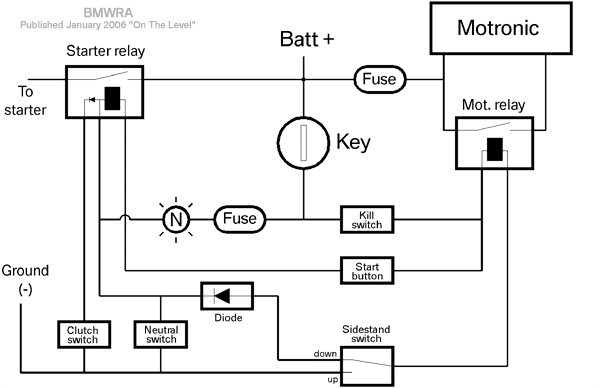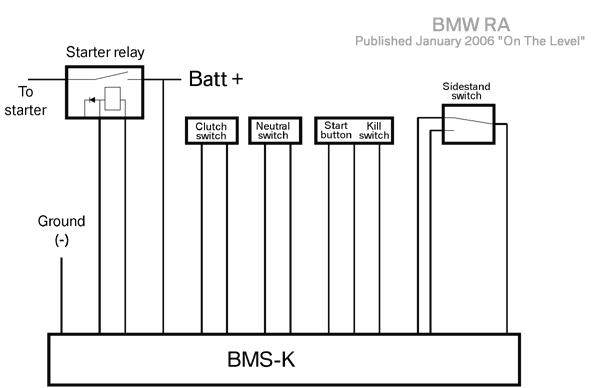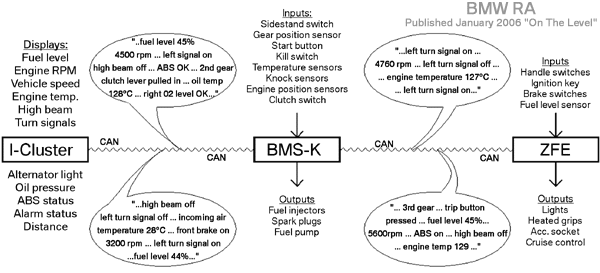Single-WHAT-System?
by Anton Largiader, OTL January 2006
Confused by the barrage of TLAs coming from BMW lately? CAN, ZFE, SWS, BMS, DWA, ABS, ESA, WAD, EWS, and stuff like that? Here's the lowdown on some of the high-tech that the new R1200 and K1200 models have brought us. One key to understanding the new BMW motorcycle electrical systems is the wiring, so we'll start by looking at the advancements there. [TLA self-referentially stands for three-letter abbreviation. –Ed.]
In classic wiring systems, power is delivered to power consumers by wires, switches, relays, and timers. The intelligence of the system is largely contained in the way that the wiring connects the relatively simple components. On older bikes this is pretty simple; the entire wiring harness on my race bike consists of five wires, and that includes the oil pressure light. But with every new component that has to interact with others, complexity increases.
The starter interlocks are a good example. Initially, we just wanted the starter to depend on the clutch and neutral switches (K75). Pretty easy: we ground the starter relay through these wires so that either one of the switches will complete the circuit. Within the relay, a diode was required to keep the clutch switch from turning on the neutral light, but it's still pretty simple. Next, we wanted the sidestand to prevent engine operation with the stand down (K1100 and early R1100). OK, still easy: we put the sidestand in series with the kill switch so either one will stop the motor, while the clutch and neutral switches (in parallel) allow the motor to start. Finally, we want the engine to run with the sidestand down if the transmission is in neutral (R1150). At this point, the sidestand switch has to be added to the 'start' side of the circuit using an additional contact, and another diode keeps it from lighting the neutral light. Since the R1100 models didn't have this wiring, BMW made a new wiring harness for the sidestand that included an extra relay to bridge the 'start' and 'kill' circuits for the police R1100RTs. And it goes on and on. List price for the K1200LT main wiring harness is $1320, for reasons like this.

Shown here is a simplified diagram of the R1150 starter interlocks described above. Even with this interconnection of wiring, the system isn't perfect. The sidestand switch disables the Motronic but not the starter, so the starter will turn and turn even though the engine cannot possibly run (sound familiar?).
Industrial machinery was going down the same path in the '80s. Huge electrical enclosures contained a sea of wiring which interconnected photoeyes, amplifiers, motor starters, pushbuttons, lights, limit switches, and so forth. Changing the operation of a machine was very time-consuming and costly. The solution was the programmable logic controller, or PLC, which is a computer with electrical input and output terminals. All of the switches and other input devices simply go to input terminals on the PLC, and the PLC's output terminals power the motors, actuators, and valves. All of the intelligence—what controls what, timing, sequencing—is contained in the program that the PLC uses. Altering the function of the machine, provided the necessary hardware was in place, became a simple matter of rewriting some of the programming. All in all, once the complexity of a machine involved more than four or five relays and timers, it was cheaper in the long run to use a PLC.
This is where BMW has gone with their motorcycles. The auto industry has been there for a decade, but BMW bikes had only made small advances in this direction before the hexhead bikes came out. For instance, the flasher unit on the earlier bikes with pushbutton turn signals is a small control unit with some input terminals, some output terminals, and electronics in between. No wires interconnect the components other than via the flasher unit. If you ground one input, the controller starts flashing the two right signal bulbs. Ground another, it flashes all four bulbs. Ground a different one, it stops all flashing. On some bikes, the flasher counts pulses from the speedometer along with time and determines when it should stop flashing. ABS units have been the same way: there are inputs and outputs, and that's about all.
However, with the R1200GS, BMW took a real plunge into this technology. It's really a much simpler system, and troubleshooting is easy. In the example of our starter interlock, each component involved (kill switch, neutral, sidestand, starter, clutch) tells BMS-K, the engine management system, what it's doing and BMS-K decides if it's safe to run the starter. This is depicted here:

However, you'll notice that the ignition key and the neutral light are not present in Figure 2. That's because they do not report to BMS-K. So how does this work?
Let's start by identifying the control modules and what they control. Every new Boxer and K has at least three modules: BMS-K, ZFE, and the instrument panel (I-Cluster).
ZFE (Zentrale Fahrzeugelektronik, or Central Chassis Electronics) controls the lights, heated accessories, horn, radio, accessory socket, and cruise control based on inputs from handlebar switches and the like. Individual control inputs go directly to ZFE, and control outputs go from ZFE to individual components (bulbs, heated grips, etc.).
The engine management unit, BMS-K (BMW Motor-Steuerung mit Klopfregelung, or engine management with knock sensor), performs a similar function for engine-related inputs and outputs. Its inputs include the starter button, kill switch, sidestand switch, clutch switch, gear position indicator, and various engine sensors. Outputs control the starter, fuel pump, injectors, ignition coils, and warning lights, among other things.
Finally, the I-Cluster displays information to the rider. The only physical input it has is the clock setting button, and the outputs are the various instruments and warning lights. These, however, are built-in and don't really count.
Two additional control modules, ABS and DWA (Diebstahl Warnanlage, the alarm system), may also be present.
OK, but this doesn't help us figure out the key and neutral light issues. Clearly there's still some sort of wiring cross-connecting these modules, right? This is where the CAN comes into play. CAN, which stands for Controller Area Network, is an automotive standard and is not BMW-specific. Details on the CAN protocol can be found on the web. The data pathways (physical wiring, generally) used by the CAN are sometimes also referred to as the CAN-bus. The control modules (ZFE, BMS-K, and I-Cluster, plus ABS and DWA, if present) use the CAN-bus to communicate with each other.
Much hype was made originally about the "Single-Wire System" (SWS) when the R1200GS came out. This was touted as a single wire connecting the various components of the motorcycle, but the term faded from use because it really wasn't accurate. The control modules are connected by the following:
- a pair of wires comprising the CAN. This is basically a data network between modules;
- power, switched power, and ground wires to each module as part of the wiring harness;
- a "wake line" connecting ZFE, the I-Cluster, and DWA (only used with DWA).
So you can see the SWS is actually more like the 6WS, but the idea is the same.

In a nutshell, each control module broadcasts information that might be of interest to other control modules. When BMS-K sees that the transmission is in neutral, it hollers "Neutral!" over the CAN. Anyone can act on the information, but only the I-Cluster really cares. It responds by turning on the green light and putting a zero in the info flatscreen. In fact, the I-Cluster is probably the best example of a CAN control module because it gets all of its information from other control modules over the CAN rather than receiving it directly as input from sensors and switches. BMS-K provides information like engine speed, temperature, oil pressure, and gear selection. ZFE broadcasts information about turn signals, high beam, fuel level, battery charging, and vehicle speed (for non-ABS bikes; the ABS models get vehicle speed from the ABS unit); the I-Cluster picks this information up and displays it. ZFE also sends the signals from the trip computer control button on the left handgrip which reset the trip odometers and cycle between various displays on the info flatscreeen. All of this chatter happens over the two wires of the CAN, as shown in Figure 3.
This is by no means an exhaustive list, but it illustrates how information is shared between modules without requiring separate wires from each sensor to each point where its information is needed. And you can also see how the sensors on the bike are wired to the control unit for which the information is critical, and the results are shared with other control modules which find the information to be merely of some interest. This gives robustness to the system: whereas removing the instrument panel on an older bike might disable the alternator or even the engine, cutting the I-Cluster wiring will have no effect whatsoever on the rest of the motorcycle. In fact, cutting the CAN bus in any place will leave each module working with the information it has, which at the very least means the brakes, lights, and engine will keep working.
CAN-bus systems
